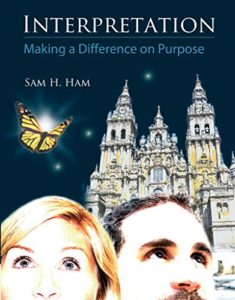Cultural, Environmental and Historical Interpretation is something that many guides do on a day-to-day basis.
The curious thing is, many tour leaders have never encountered the term ‘interpretation’
Well, for starters, we are not talking about interpretation between languages or other types of translation services. Those are a skill unto themselves – but not what we are talking about today.
In this instance, we mean the interpretation of culture, the environment or history as done by an educator, park ranger or tour guide. Or in other words, think of interpretation as simply a communication strategy.
It’s presenting your information in such a way that it resonates with your audience.
National Park Rangers, naturalists, outdoor educators and guides working in eco-tourism, are much more likely to have been exposed to the term ‘interpretation’, but even if you have never heard of ‘interpreting’ before – there is a lot to learn from the people teaching in this space.
The field of ‘thematic interpretation‘ is an approach originally advocated by Professor William Lewis (University of Vermont) and subsequently developed by Professor Sam H. Ham from the University of Idaho.
For this video, we reached out to Dr. Ham in order to get the best advice we could on rocking our interpretive moments.

We share some interpretation tips for tour guides, but also explore one of Dr. Ham’s central teachings, the T.O.R.E. model of thematic interpretation. This method is outlined in his recent book, ‘Interpretation: Making a Difference on Purpose’, which can be found online from Amazon.
To give you a little taste, The TORE method is actually an acronym and a guide to effective interpretation.
Dr. Ham defines ‘interpreting’ as a process aimed at provoking audiences to do their own thinking and thereby develop their own understanding of your topic.
As you’ll see, by presenting information with a strong, relevant theme, researchers have found that audiences are more engaged and more likely to think deeply about what you’re saying.
The four qualities outlined by the TORE model actually emerged from a huge body of research on how humans respond to communication when it’s done well.
We go through an interpretative example in detail in the video, but essentially the delivery of your presentation should have four things:
1. It needs a theme (T)
2. It needs to be organized (O)
3. It needs to be relevant (R)
4. It needs to be enjoyable (E)
We take a look at each in turn and share some interpretation techniques and best practices.
Kelsey: Hi there, today we’ve got a special guest, Sarah Bassendale, one of our lead trainers at the Be a Better Guide Academy.
Sarah: Hi there Sarah and Kelsey here from Be a Better Guide. Today we’re going to be looking at the book ‘Interpretation – Making a Difference on Purpose’ by Dr. Sam Ham, a professor at the University of Idaho.
What got us excited about doing this video is that the field of interpretation is better known by guides who work in environmental or natural fields. For example, National Park Rangers, or Guides working in Zoos or aquariums.
Kelsey: But this what we love here at Be a Better Guide – Learning from one another and taking best practices that work in one field and using them to make us better tour leaders.
In this short video, we’re going to look at one of Dr. Ham’s central teachings, the T.O.R.E. model of thematic interpretation – Let’s dive in!
Sarah: Dr. Ham defines interpretation as a process aimed at provoking audiences to do their own thinking and thereby develop their own understanding of your topic.
As you’ll see, by presenting information with a strong, relevant theme, researchers have found that audiences are more engaged and more likely to really think about what you’re saying.
In other words, think of interpretation as a communication strategy. It’s putting together your information in a way that resonates with your audience.
Kelsey: The T.O.R.E. model developed by Dr. Ham, is an acronym and guide to effective interpretation. These four qualities emerged from a huge body of research on how humans respond to communication when it’s done really well.
Sarah: Interpretation needs to be four things
1) It needs to have a theme (T).
2) Be organized (O).
3) Be relevant (R).
4) and be enjoyable (E).
Let’s take a look at each of these.
Kelsey: Your information should have a theme. While presenting or sharing info on a topic, a theme makes your job easier because it helps you decide what to include, what to exclude and what to emphasize.
It gives you a rule for making what would otherwise be a daunting decision: “From all my knowledge on this topic, what should I share with my group today?”
But remember we don’t want to confuse a ‘Topic’ with a ‘theme’
The major difference is that a topic is merely the subject matter of the presentation, whereas a theme is the main point or idea we’re trying to convey about that topic.
Sarah: For example the topic is ants. Theme – Ants could teach present-day miners a thing or two about underground architecture. Ants are able to solve architectural problems in ways that we are still trying to understand.
As a Guideline, we want our theme to be simple and to be able to say it in a single sentence. It should answer the audience’s question “So What?” Why should I care about this particular topic?
Kelsey: Your information should be Organized. Interpretation is organized when it’s presented in a way that’s easy to follow. In other words – interpretation on tour is at its best when it doesn’t require a lot of effort from the audience.
As the amount of work your group has to do increases, the likelihood that they’ll continue to pay attention decreases. This often happens if your presentation is dense, complicated or hard to follow.
Sarah: There are lots of ways to organize your presentation, but here’s a rule of thumb: Dr. Ham references over a dozen studies that show that most people can handle about four different pieces of information at a time. Meaning you want no more than 4 main ideas within your theme.
Let’s clarify this with an example: If our theme is Ants could teach present-day miners a thing or two about underground architecture. Our four main talking points could be:
1) Size and Scaling – The largest ant colony discovered to date stretches over 4000 miles across Europe and is suspected to have billions of ants.
2) Design – Many larger ant colonies have transit tunnels, ventilation inflow and outflow shafts, fungus gardens and trash pits.
3) Efficiency – Rather than working as individuals, ants function as parts of a collective whole, doing what is best for the colony.
4) Master Communicators – ants are able to rapidly coordinate their efforts by using their antenna to smell the chemicals that other ants release.
And you could have some talking points for each of these sub themes
In sum, Instead of listing unconnected facts, or delivering a stream of consciousness, take the time to organize your delivery. Remember, no more than 4 additional ideas in your central theme.
Kelsey: 3) Your information should be Relevant
A presentation that’s relevant to our audiences has two qualities: it’s meaningful AND it’s personal.
Meaningful means we’re able to connect information to something already inside our brains. In other words, we can relate to it, or it has context for us from previous experience.
The classic example of something not being meaningful. is someone using a bunch of technical terms or acronyms when trying to explain something.
You see everyone, we’ve got to dynamically predominate enterprise-wide users in order to proactively utilize EDPs and market-driven best practices.
….I couldn’t agree more.
Sarah: Whenever we introduce NEW concepts to our groups, we have to connect them to things our audience already knows about. We can use examples, analogies, contrasts, smilies or metaphors to help make connections
For example, To explain the strength of ants to a group, we could ask them to imagine their fathers picking up an SUV and walking down the street.
Kelsey: Tours leaders must not only find a way to link their presentation to something their audiences know about – but also to something they CARE about.
Great you’re thinking, how the heck do I do that? Well, it may be easier than you think. Studies show that there are certain ‘universal concepts’ that have always had special significance to us as humans beings.
These include emotions such as love, hate, fear and sorrow, basic biological similarities such as hunger, thirst, birth and death, or even our fascination with uncertainty, the cosmos and morality.
Sarah: Almost every story, movie, or television series revolves around one or more of these universal concepts.
So for our purposes, use these universals to make your audience care about your theme and create a deeper connection with your material
For example, beyond impressing people with all of our ant facts, talk about how important they are to us as human beings.
Without ants to disperse seeds, pollinate plants, and aerate the soil, we humans wouldlose the all-stars of our gardens, farms and ower beds!
Kelsey: And Lastly, Your Interpretation should be Enjoyable.
Successful communication is enjoyable when it is mentally pleasing or satisfying. This can mean entertaining and engaging, but it also covers things are not necessarily fun or or lighthearted.
Lots of us enjoy paying attention to things that are sometimes sad or scary, shocking or even depressing.
Sarah: Most audiences will enjoy being involved in some way and will appreciate humor and levity. Engaging their 5 senses is a great idea, as well as using interaction, music, props, and visual aids.
Generally, try and be informal and use a casual or conversational tone.
Finally, as Louis Armstrong once sang, “When you’re smiling, the whole world smiles with you.” If you look like you’re relaxed and having fun as the tour leader, your audience will begin to feel that way, too.
Kelsey: So, as a quick recap, here is the full TORE method: Your interpretive moments should be thematic, organized, relevant and enjoyable
Think of this Acronym as another tool in your toolbox for inspiring your guests to care more deeply about the information you share.
To help you with this, we’ve created a PDF Cheat Sheet of the TORE method, which you can use when you’re working on your tours. Grab a copy by clicking below.
Sarah: We would also highly recommend Dr. Ham’s Book ‘Interpretation – Making a Difference on Purpose’ There are a ton of great tips for improving your tours. we’ll put a link for the book below as well
Kelsey: Share this video if you are inspired, and let us know in the comments if you have some other advice for great interpretation.
Thanks so much for being here and we’ll see you next time.




